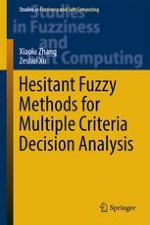2017 | OriginalPaper | Chapter
6. Heterogeneous Multiple Criteria Group Decision Analysis
Authors : Xiaolu Zhang, Zeshui Xu
Published in: Hesitant Fuzzy Methods for Multiple Criteria Decision Analysis
Publisher: Springer International Publishing
Activate our intelligent search to find suitable subject content or patents.
Select sections of text to find matching patents with Artificial Intelligence. powered by
Select sections of text to find additional relevant content using AI-assisted search. powered by
